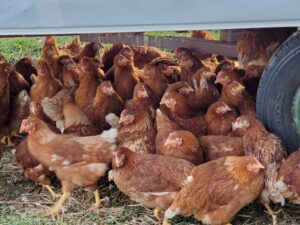The excessive amount of rainfall in October (5.06 inches) delayed planting of winter wheat and other fall grain cover crops in some areas of the state. As recorded by the Rutgers NJ State Climatologist Monthly Climate Tables, in Salem County, the precipitation in October (3.74 inches) was near normal (30-year average) and temperatures averaged a high of 63.2 degrees F. Small grains that benefited from this moisture put on more above ground biomass than November plantings if they were not planted in overly saturated soil conditions conducive for causing poor stand establishment.
In November, state-wide saw only .98 inches fall compared to the norm of 3.36 inches. In Salem County, the deficit was even more, with only .72 inches falling compared to the norm of 3.18 inches with temperature highs of 44.7 degrees. Carry over moisture from October should have been adequate in most areas of the county to optimize seed germination. Late plantings in December were possible due to above normal temperatures of 43.9 degrees, but soil moisture was lacking due to only 1.18 inches falling compared to the thirty-year average of 4.0 inches.
The back-to-back months of little precipitation coupled with windy conditions did not yield rapid development of the crop compared to field observations in 2020. Despite the near normal precipitation state-wide in January (3.45 inches) small grains gained little beyond shoot and early tillering stage with average temperature highs of only 28.7 degrees state-wide and 31.4 degrees in the county the first month of 2022.
Temperatures were all over the place in February with two days above 70 degrees the week of February 20th in Salem County, enough to bring winter wheat out of dormancy since February 7th. Near normal precipitation (2.88 inches) in February encouraged growth and applications of nitrogen fertilizer are ongoing as the crop rapidly develops.
Nitrogen fertilizer prices have climbed steadily since this time last year, and more than doubled since the crop was planted in October. The combination of moisture, warm weather and soil conditions should optimize any recent applications. Areas that received more than a half an inch in the last seventy-two hours (Estimated Precipitation, Mid-Atlantic River Forecast Center) should monitor moisture conditions carefully to track utilization of applied nitrogen if future precipitation exceeds 3 inches in the next two weeks. In February, nitrogen prices were still well above $600 /ton for products like UAN28, UAN32 and Urea. DAP, MAP, and Potash remained above $800/ton and anhydrous ammonia soared above $1000/ton.
Fertilizer pricing real time:
- The CRU FertilizerWeek1 tweets on the impact of the war with Ukraine provide a useful snapshot of the volatility in the market. https://twitter.com/FertilizerWeek1/status/1499759162900762626/photo/1
- Barchart: https://www.barchart.com/futures/quotes/JC*1
- Progressive Farmer DTN: All commodities: https://www.dtnpf.com/agriculture/web/ag/home
 The United States Department of Agriculture’s (USDA) Animal and Plant Health Inspection Service (APHIS) has confirmed findings of highly pathogenic avian influenza (HPAI) H5N1 in wild birds in South Carolina and North Carolina. Wild birds can be infected with HPAI and show no signs of illness. They can carry the disease to new areas when migrating. APHIS anticipates additional wild bird findings as robust wild bird sampling program continues into the spring. – For the full press release see the APHIS website.
The United States Department of Agriculture’s (USDA) Animal and Plant Health Inspection Service (APHIS) has confirmed findings of highly pathogenic avian influenza (HPAI) H5N1 in wild birds in South Carolina and North Carolina. Wild birds can be infected with HPAI and show no signs of illness. They can carry the disease to new areas when migrating. APHIS anticipates additional wild bird findings as robust wild bird sampling program continues into the spring. – For the full press release see the APHIS website. 